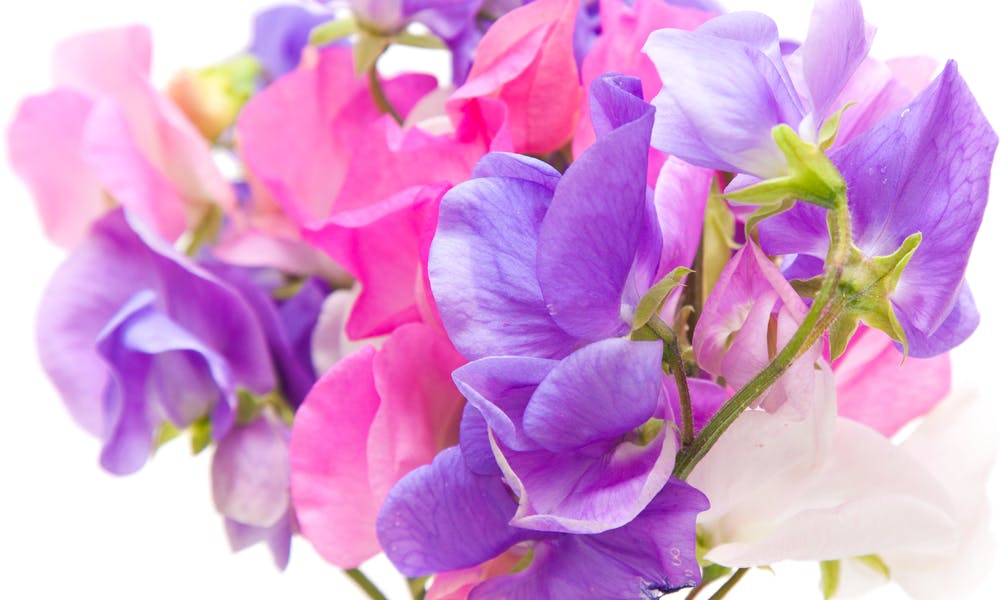MENU
April Birth Flowers: Presenting the Daisy and Sweet Pea

The month of April is filled with holidays, with Easter and Good Friday sparking thoughts of renewal and hope. Families gather to celebrate and give thanks for all that the year has brought them, but no one celebrates more than those who happen to have their birthdays within this month as well. In the world of flowers, those born within this month are tied to the daisy and sweet pea blossoms, and we explore all the history and symbolism that go along with these two lovely flowers.
Keep on reading to find out the:
- Daisy Flower Origins
- Sweet Pea Flower Origins
- Daisy Symbolism
- Daisy Color Meanings
- Sweet Pea Symbolism
- Growing a Daisy
- Sweet Pea Growing
Daisy Flower Origins
Part of the Asteraceae family, the daisy we all know and love is natively found in the north, west, and central parts of Europe, as well as North Africa. Known scientifically as bellis perennis, it is a perennial flowering plant that is herbaceous. The flower has been widely cultivated, with thousands of varieties having been created. It has been naturalized in most parts of the world now. It has been used traditionally for centuries in teas and poultices to treat wounds and disorders of the stomach and lungs. It is quite popular in cuisine and can be found in many salads and sandwich recipes.
Sweet Pea Flower Origins
An annual flowering plant of the genus lathyrus odoratus, the sweet pea flower is a native plant of parts of Europe, with Italy being most dominant. It is a member of the fabaceae family. A climbing plant, it can grow from 3 to 6 feet in height, so long as it has enough room to spread out. It has large, pinnate leaves that are generally a dark, purple color in the wild, although many of the newer cultivars have other shades such as red, pink, and blue. With its lovely fragrance, it is found in many gardens throughout Europe, although it is quite toxic so care should be taken if you have children or pets.
Daisy Symbolism
The term bellis perennis is thought to stem from the Latin words for pretty and everlasting, which speak to the daisy’s eternal beauty. The daisy is thought to symbolize innocence and purity and is commonly associated with children. It relates to ideas of renewal and rebirth, and very tied to the value of trust. Another common association with the daisy is that of love, with most people having played the amusing game of picking off daisy petals one by one in the hopes that they receive a sign of whether someone they have a crush on loves them in return. In pagan times, people would hang daisies around their homes to receive the blessings of faeries for good luck in the coming year. Some women would even wear the flowers in their hair to bring luck and attract a lover’s attention.
Daisy Color Meanings
The white daisy is thought to symbolize purity of spirit and an innocent soul. Due to its simple exterior, it has been tied to ideas of simplicity and minimalism. The yellow of the daisy, which gives it a similar appearance to the sun has given rise to its association with daily renewal, just as the sun rises and sets every day.
Sweet Pea Symbolism
The name lathyros is derived from the old Greek term for pea or pulse while odoratus is thought to mean fragrance. Within the world of flower symbology, the sweet pea has become associated with ideas of pleasure, delight, and beauty. Many cultures use it as a parting gift to friends and family, a sort of good luck and goodbye charm. Its common name sweet pea is thought to stem from the famous poet John Keats, who wrote of it in one of his poems.
Growing a Daisy
The common daisy is quite simple to grow. It can flourish with full sunlight or with some partial shade. Well-drained soil is recommended, but it is quite hardy and can grow in most healthy soil. The daisy does well with a good amount of watering, especially around its initial planting. Keep watering throughout the season.
Sweet Pea Growing
The sweet pea flower is typically grown on tripods of bamboo. Many people mix them into vegetable gardens, as they attract pollinators such as bees, which help keep the garden healthy. Being annuals, they grow relatively easy in any environment. Full sunlight or partial shade is recommended. They tend to prefer more alkaline soil, that is well-drained. Putting a layer of mulch around each planting can aid in their growth. They require feedings of water and fertilizer every month during their growing season. If you plan on growing them indoors, start at least four to five weeks out. Bedding them in a light soil with peat seems to be ideal. Be patient with the sweet pea, as it can take quite a long time for it to germinate. Rabbits and groundhogs tend to like sweet pea seeds, so be wary once you have transplanted them outdoors.
The Simple Beauty of Aprils Birth Flowers
The sweet pea and daisy exemplify how nature in all its complexity can create beauty out of such simple looking flowers. For those coming into the month of April with fears of aging, these flowers instead remind us that each year is a time for change and rebirth, a time to look forward and be the best version of ourselves, and that all it takes is focus and simple down to earth hard work to create a good life. For anyone looking to add some new faces to their gardens or just brighten up their homes, grabbing a sweet pea or daisy as a birthday gift for yourself or a friend is a great idea!

